Related Research Articles

Brandy is a liquor produced by distilling wine. Brandy generally contains 35–60% alcohol by volume and is typically consumed as an after-dinner digestif. Some brandies are aged in wooden casks. Others are coloured with caramel colouring to imitate the effect of aging, and some are produced using a combination of aging and colouring. Varieties of wine brandy can be found across the winemaking world. Among the most renowned are Cognac and Armagnac from south-western France.

Cognac is a variety of brandy named after the commune of Cognac, France. It is produced in the surrounding wine-growing region in the departments of Charente and Charente-Maritime.

Zinfandel is a variety of black-skinned wine grape. The variety is grown in over 10 percent of California vineyards. DNA analysis has revealed that it is genetically equivalent to the Croatian grapes Crljenak Kaštelanski and Tribidrag, as well as to the Primitivo variety traditionally grown in Apulia, Italy, where it was introduced in the 18th century, and Kratošija in Montenegro. The grape found its way to the United States in the mid-19th century, where it became known by variations of a name applied to a different grape, likely "Zierfandler" from Austria.
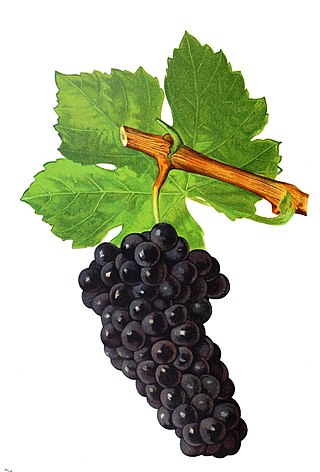
Durif is a variety of red wine grape primarily grown in Australia, California, France, and Israel. Since the end of the 20th century, wineries located in Washington's Yakima River Valley, Maryland, Arizona, Texas, West Virginia, Chile, Mexico's Baja California Peninsula, and Ontario's Niagara Peninsula have also produced wines from Durif grapes. It is the main grape known in the U.S. and Israel as Petite Sirah, with over 90% of the California plantings labeled "Petite Sirah" being Durif grapes; the U.S. Bureau of Alcohol, Tobacco, Firearms and Explosives (ATF) recognizes "Durif" and "Petite Sirah" as synonyms for the same grape. It produces tannic wines with a spicy, plummy flavour. The grape originated as a cross of Syrah pollen germinating a Peloursin plant. On some occasions, Peloursin and Syrah vines may be called Petite Sirah, usually because the varieties are extremely difficult to distinguish in old age.
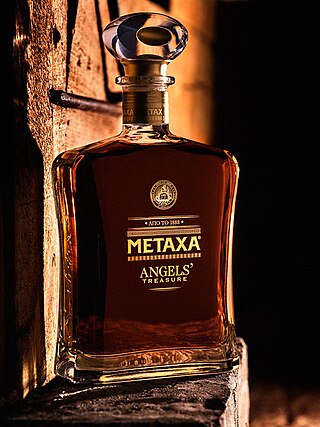
Metaxa is a line of branded Greek alcoholic drinks, each a flavored amber blend of spirits and Muscat wine, aged in oak barrels, and packaged in amphora-shaped bottles. Several Metaxa products have numbered “star” designations indicating, according to different sources, either the product’s age, the number of base spirits and wines used in making it, or simply the quality level. Metaxa's main exported products are 5 Star, 7 Star, 12 Star, and Private Reserve.

Grappa is an alcoholic beverage: a fragrant, grape-based pomace brandy of Italian origin that contains 35 to 60 percent alcohol by volume. Grappa is a protected name in the European Union.

Armagnac is a distinctive kind of brandy produced in the Armagnac region in Gascony, southwest France. It is distilled from wine usually made from a blend of grapes including Baco 22A, Colombard, Folle blanche and Ugni blanc, traditionally using column stills rather than the pot stills used in the production of cognac, which is made predominantly from ugni blanc grapes. The resulting spirit is then aged in oak barrels before release. Production is overseen by the Institut national de l'origine et de la qualité (INAO) and the Bureau National Interprofessionel de l'Armagnac (BNIA).
GALLO is a winery and distributor headquartered in Modesto, California. It was founded in 1933 by Ernest Gallo and Julio Gallo of the Gallo family, and is the largest exporter of California wines. It is the largest wine producer in the world, producing over 3% of the world's entire annual supply of 35 billion bottles with an annual revenue of $5.3 billion it is also the largest family-owned winery in the United States. Gallo provides about 3,500 jobs to Modesto residents and 2,500 jobs in other parts of the state, country, and world.
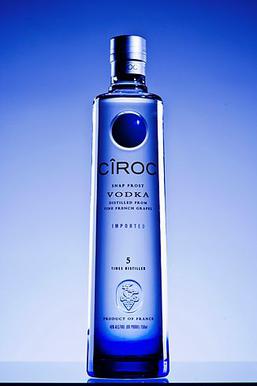
Cîroc is a brand of alcoholic beverages produced in France since 2003 and owned by the British-based multinational alcoholic beverage maker Diageo. The brand family includes vodka, flavored products containing vodka, and brandy. From 2007 the marketing and promotion for Cîroc in the United States was in conjunction with rapper Sean Combs in an "equal-share venture" with profits from the brand being split between Combs and Diageo, but this was terminated in 2024 after a legal dispute, leaving Diageo the sole owner.

Pineau des Charentes, is a regional aperitif of western France, made in the départements of Charente, Charente-Maritime, and Dordogne. While popular within its region of production, it is less well known in other regions of France and somewhat uncommon abroad.

A microdistillery is a small, often boutique-style distillery established to produce beverage grade spirit alcohol in relatively small quantities, usually done in single batches. While the term is most commonly used in the United States, micro-distilleries have been established in Europe for many years, either as small cognac distilleries supplying the larger cognac houses, or as distilleries of single malt whisky originally produced for the blended Scotch whisky market, but whose products are now sold as niche single malt brands. The more recent development of micro-distilleries can now also be seen in locations as diverse as London, Switzerland, and South Africa.
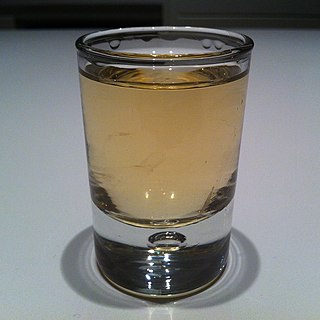
Chacha is a Georgian pomace brandy, clear and strong, which is sometimes called "wine vodka", "grape vodka", or "Georgian vodka/grappa". It is made of grape pomace. The term chacha is used in Georgia to refer to grape distillate. It may be also produced from unripe or wild grapes. Other common fruits or herbs used are figs, tangerines, oranges, mulberries or tarragon.

The Mendocino County wine is an appellation that designates wine made from grapes grown mostly in Mendocino County, California. The region is part of the larger North Coast AVA and one of California's largest and most climatically diverse wine growing regions. Mendocino County is one of the northernmost commercial wine grape regions in the state with two distinct climate zones separated by the Mendocino Range. Ten American Viticultural Areas have been designated within Mendocino County. Mendocino is one of the leading wine growing regions for organically produced wine grapes. Nearly 25% of the acreage in Mendocino County is grown organically. In 2004, the residents of the county voted to become the first GMO-free county in the United States in an initiative that was supported by many of the county's largest wineries. The county's widespread focus on organic viticulture has inspired journalists to describe it as "California's organic wine Mecca".

Yerevan Ararat Brandy Factory, officially known as the Yerevan Ararat Brandy-Wine-Vodka Factory, commonly known by its famous brand Noy, is a leading Armenian brandy production company in Yerevan, Armenia, currently owned by Gagik Tsarukyan's Multi Group Concern. It was founded in 1877 during the rule of the Russian Empire. The factory is located on the left bank of the Hrazdan River at the centre of Yerevan, occupying the area of the historic Erivan Fortress.
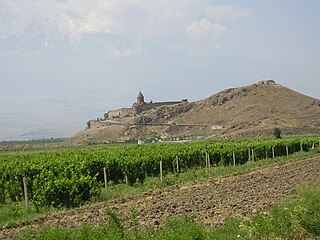
Armenian wine is wine made in Armenia and the Armenian-populated Republic of Artsakh, in the region of South Caucasus. Armenia is one of the oldest wine producing regions of the world. In particular, the oldest known winery, Areni-1 winery, was found in Armenia's Areni region, which is still known for its wine production and endemic grapes.
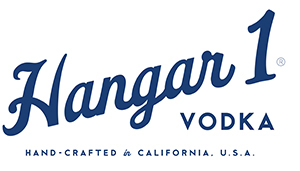
Hangar 1 Vodka is a vodka brand produced by The Hangar 1 Distillery in Alameda, California. In addition to vodka, the distillery also produces spirits, some of which were formerly produced by St. George Spirits. The brand is owned and distributed by Proximo Spirits of Jersey City, New Jersey, and is available as a straight vodka as well as in a variety of flavors.

Sazerac Company, Inc. is a privately held American alcoholic beverage company headquartered in Metairie in the metropolitan area of New Orleans, Louisiana, but with its principal office in Louisville, Kentucky. The company is owned by billionaire William Goldring and his family. As of 2017, it operated nine distilleries, had 2,000 employees, and operated in 112 countries. It is one of the two largest spirits companies in the United States, with annual revenue of about $1 billion made from selling about 300 beverage brands.
Peach Street Distillers is a privately owned brewery and distillery in Palisade, Colorado. It was established in November 2005 by Rory Donovan with Bill Graham and David Thibodeau, the co-founders of Ska Brewing Company in Durango, Colorado.

Clear Creek Distillery is a distillery based in Hood River, Oregon, United States, and formerly in Portland, Oregon. Founded in 1985, it has been owned by Hood River Distillers since 2014. It is most well known for its eau de vie produced from Bartlett pears, though today it also makes a variety of other fruit brandies, aged spirits, and liqueurs.
The Marzadro Distillery is an Italian family run company created at the end of World War II. Its birth and evolution follows closely the economic transformation of Italy and the modernization of its means of production, in particular in the Northern part of the country. The company is located in the historical region for the production of grappa. Together with other distilleries in the regions of Trentino, Veneto, Friuli, Piemonte and Lombardia has made important contributions that have changed the character of this liquor from an ammazzacaffè to a liquor worthy of international recognition. Initially, the distillery operated only locally, distilling pomace to produce grappa and other liquor. Currently it benefits from a national and international network of distribution.
References
- ↑ Matt Villano (2008-11-30). "Exquisite brandy one of Ukiah area's delights". San Francisco Chronicle.
- 1 2 Frank J. Prial (1994-08-03). "Wine Talk". New York Times.
- 1 2 Frank J. Prial (1988-09-04). "Wine: A Choice Encounter". New York Times.
- 1 2 3 4 5 6 W. Blake Gray (2005-01-27). "Over a barrel: Germain-Robin makes superb brandies, yet they're hard to sell". San Francisco Chronicle.
- ↑ K.C. Meadows (2012-06-15). "Spirit moves him: Germain-Robin writes a book". Ukiah Daily Journal.[ permanent dead link ]
- ↑ "E. & J. Gallo buys Germain-Robin luxury brandy distiller in Mendocino County". North Bay Business Journal. 2017-08-17. Archived from the original on 2017-10-11. Retrieved 2017-10-10.